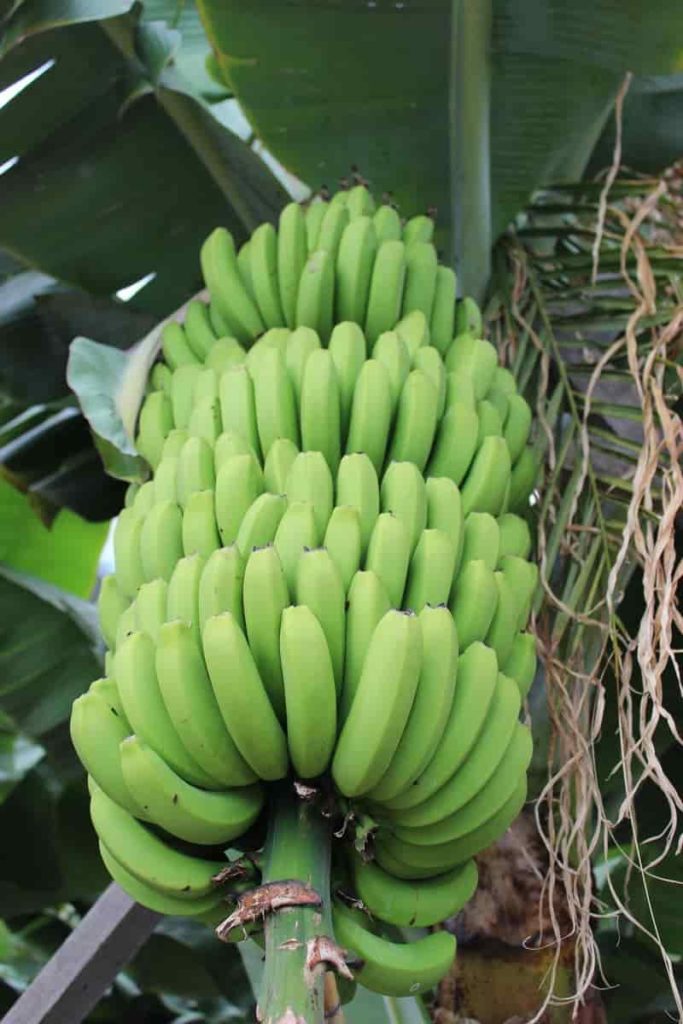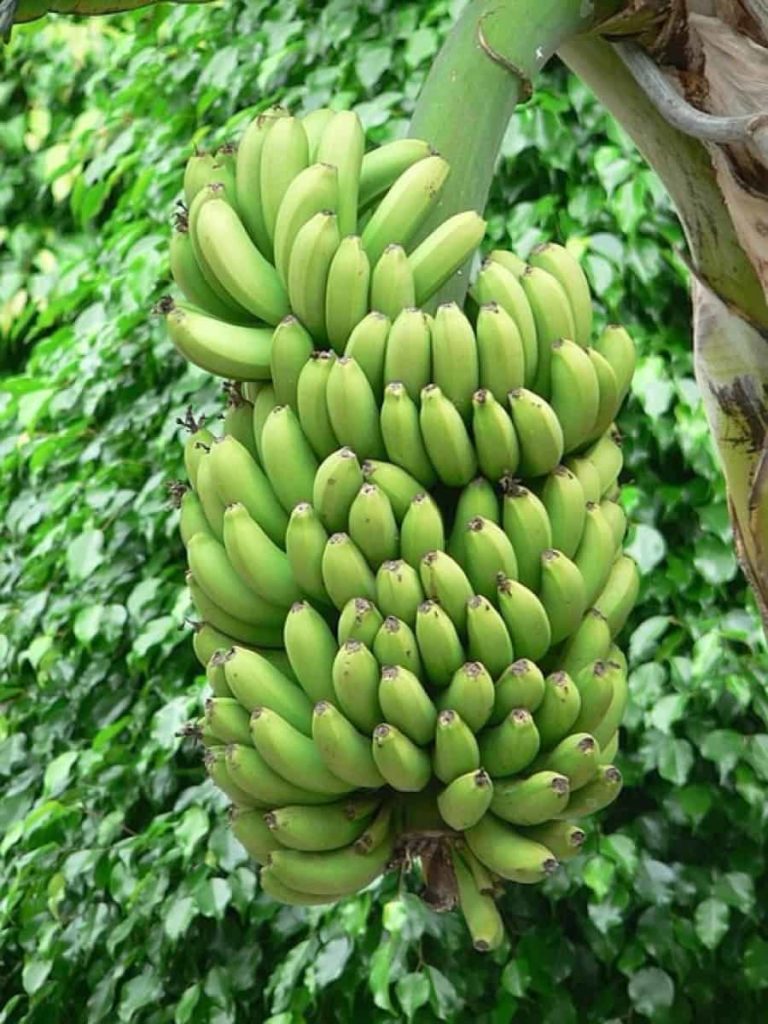Banana plants can be grown in a relatively wide range of soil conditions. Two important factors to be considered are soil depth and drainage. The Banana crop requires a depth of at least 50 centimeters and well-drained, fertile soils. Any soil that contains water can kill a Banana tree faster. This means that the soil you use to plant your Banana tree should include loamy, sandy soils, not fine sand that clings together, but large grains that flow easily or a mixture of your garden soil and perlite to improve drainage.

You can also add a few small to medium-sized rocks to the soil around the tree, which can increase soil drainage capacity. If your Banana tree is properly draining soil, frequent watering helps the soil to remain moist without getting too wet. A soil that is not very acidic and not very alkaline is rich in organic material with high nitrogen content, adequate levels of phosphorus, and potash are good enough for Bananas. The soil of low-lying areas is avoided; very sandy with poor drainage. Let’s check out how to prepare the soil for Banana plants below.
How to Prepare the Soil for Banana Plants
Soil pH for Banana
Bananas prefer more acidic soil with a pH between 6 to 7.5. Low pH soil makes Bananas more susceptible to Panama disease. Avoid soil that is sand, salt, nutrient deficiency, and poorly drained. Improve the soil if it is not in the most favorable condition. You can improve nutrient-deficient soil by adding organic matter to the soil before you plant your Bananas and mixing them thickly. Bananas do not tolerate water logging because their roots will rot. However, you can solve it by planting the Banana in the raised beds.
Acidity levels help the trees absorb potassium, which they pass on to their fruit. In a mild climate, Banana trees don’t always produce fruit, fruit growth usually takes hot, humid days above 30°C, but the plant’s desire for potassium is still the same. Soil with a pH of more than 7.5 can kill the Banana tree, so if the pH starts to rise, add some sulfur in spring.
Preparation of soil for growing Banana in pots
Growing a Banana tree requires well-draining soil, sandy soil rich in organic matter, and compost. If you are making potting mix at home, mix sand, perlite, and compost or manure. Ideally, the Banana plant soil should contain a bit acidic pH between 5.5 and 7.0, so consider adding the soil modifier if necessary.
In case you missed it: Guide to Growing Red Banana in Home Garden: Planting and Care
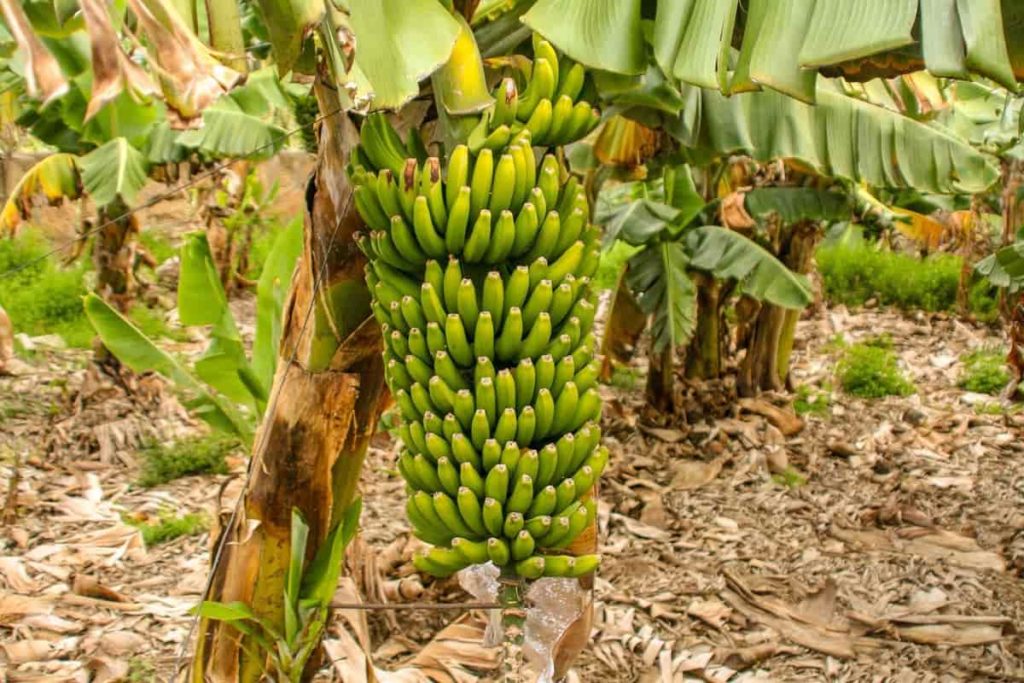
Choose potting soil mix high in organic matter, as it will help release nutrients slowly over time to feed the plant continuously. Banana plants develop deep root systems, so small varieties need to be planted in large pots to give enough room for roots to grow. Choose a container with several drainage holes to ensure water is easily drained from the soil.
Preparation of soil for growing Banana on grounds
Banana trees are tropical plants that require a warm climate and excessive sunlight. Your tree needs at least 6 hours of direct sunlight per day. However, most Bananas thrive 12 hours a day directly in sunlight. Banana trees want well-drained, fertile soil, and the best sandy soil. The soil must drain well as excess water leads the Bananas to develop root rot very quickly.
Prepare your soil in advance by adding plenty of compost or manure and irrigating well a few days before planting. If you are growing a few Banana plants, keep them at a distance of four meters. When planting, make a raised mound around the Banana to improve drainage around the roots. Banana plants need abundant sunshine and rich, well-draining, sandy soil.
Make sure to provide proper space for Banana trees, so they do not steal essential nutrients from nearby plants. Banana trees are heavy feeders that require a ton of nutrients for the best growth. Heavy feeders are known to steal nutrients from nearby plants. As a result, considerable planting distances are essential for the health of any plant that can grow near your tree. Keep in mind that the Banana roots can reach 30 feet in width, so look for a location of at least 15 feet from other plants.
How to grow Banana in clay soil
Clay soil with proper drainage, and drained loamy soil, is suitable for growing Bananas. Loosen the soil before planting and work in three buckets of compost and one bucket of organic manure per plantation site. Make a mound about 15 centimeters above the surrounding soil to help drainage. It is particularly important in clay soil. Firm the soil, then mulch with compost, hay, straw, or sugarcane; place the mulch about 50 centimeters away from the base of the clay soil.
In case you missed it: Best Fertilizer for Banana Plants: Schedule, Organic, Natural, and Npk
Soil composting for Banana
Enrich the plantation hole with any organic matter combination: aged mushroom compost, aged manure, kitchen scraps, leaves, and rotten pine bark mixed with soil dug from the hole. Bananas are hungry plants. They need a lot of energy to grow, bloom and produce fruit as fast, even if it’s inedible. Adding organic material around the plant, such as healthy amounts of compost, can keep your Banana plant growing strongly.
Fertilize the plant several times during the growing season, which is relatively high in potassium. After planting, mulch the tree using organic matter, such as chopped leaves. A single layer of mulch helps the soil maintain moisture, protecting it from root rot. Bananas prefer soil that is slightly moister than humid conditions. Mulching will provide an ideal environment if you avoid giving more water. Fungal infections can start faster if Banana plants get too much water.
Land preparation for Banana
Before planting Banana plants, grow the green manuring crop like a Daincha, and Cowpea plow insists on the field. You should plow the selected field 4 to 6 times, and the weather should be allowed for two weeks. A Rotovator or harrow breaks the clumps and gives the soil a good tilt. During soil preparation, the basic dose of Farmyard manure is added and mixed well into the soil. Next, the ground is leveled by passing a laser leveler.
The earth’s surface through laser leveler is a proven technology that is extremely useful in conserving irrigation water. Laser land leveling is leveling the field within the specific degree of the required slope using a guided laser beam throughout the field. The size of the 45 X 45 X 45 centimeters pit is commonly required. You will refill the pits with topsoil by mixing them with 10 kg of well-rotten manure and 250 grams of neem cake.
In areas where the problem of nematodes is prevalent, nematicides and fumigants are also included in the pits before planting. Ready pits are left on solar radiation to help kill harmful insects, effective against soil-generated diseases, and aid aeration. Saline alkali soil above pH 8 is to be modified to include the organic matter in the pit. The addition of organic matter helps in reducing salinity, while the addition of perlite improves improvement, porosity, and aeration. Bananas need a little acidity in neutral soils to produce nutrient-rich Bananas.
In case you missed it: Banana Planting Questions and Answers – (FAQs)
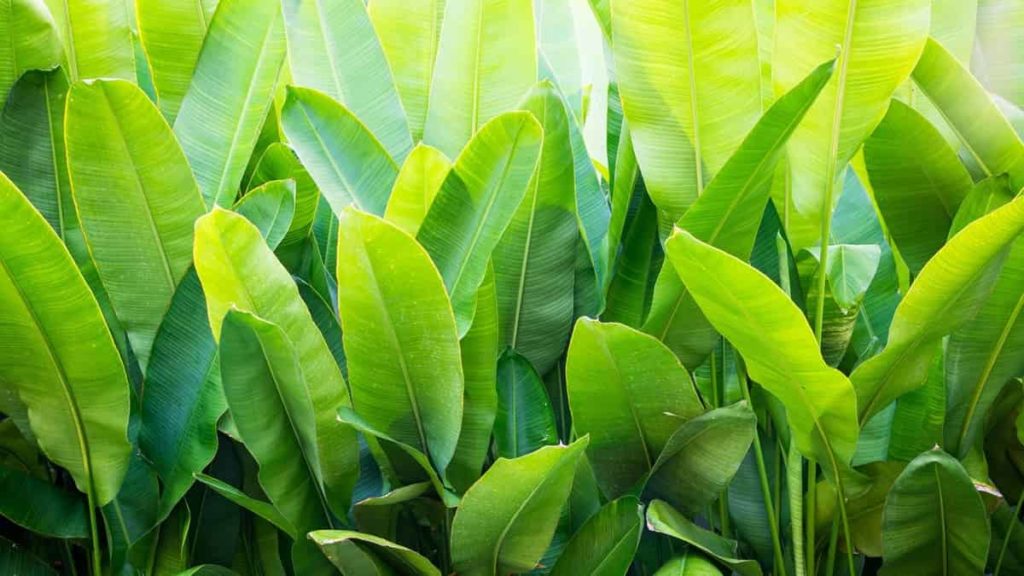
Best soil mix for Banana
While Banana plants like regular water and moisture, they don’t like to sit in water. This means you’d buy a well-draining soil mixture. A mixture of perlite, coco-coir, and pine chunks is a good choice. When buying potting mix for your Banana plant, go for the quality. Bananas need well-drained, sandy soil with organic matter and compost. You can make your potting mix; ensure you include sand, perlite, compost, or manure.
Soil recipe for Banana
- If you have difficulty finding the right potting soil, you can use the potting soil suitable for growing cactus plants. A mixture of cactus or palm tree soil is an excellent choice for Banana trees.
- Two parts of potting soil, 1 part perlite and 1 part of the pumice or sand, will provide proper drainage to your Banana.
Natural soil amendments for Banana
Banana plants need full sun, organic matter, and lots of fertilizer to keep excellent and healthy fruit trees as they are heavy feeders. Remove weeds and grass from the selected site. Next, spread 6 inches of well-rotted compost in this area. Organic compost is made from hay, straw, grass clippings, leaves, rabbit manure, chicken manure, and seaweed. Dig up to 12 inches deep soil with the shovel and mix the compost into the soil.
Spread 2 to 6 inches of organic mulch around the base of the plant. Place the mulch 2 to 6 inches from the trunk and expand the mulch layer to 2 to 6 feet on the root zone. Chopped bark and wood chips are good mulch for Banana plants. Mulch maintains soil moisture, reduces weed growth, and provides the plant with slow-release organic nutrients. You can put organic manure under the hole before adding a two-inch base of appropriate soil. Next, place the Banana plant in the hole and add the soil while gently compacting around the roots.
In case you missed it: Banana Growing Tips, Techniques, Ideas, and Secrets
What to do with soil when growing Banana
Choose the plants that match the Banana plant’s climate and the soil type. Palm trees, as an overstory plant, can provide partial shade for Banana plants, especially in hot and dry weather. Palm trees are also 30 to 50 feet long and provide fruits like Coconut and Dates. Yuca is another edible plant that grows in subtropical areas and deserts. It makes them a great drought-tolerant plant to use with Banana plants.
The roots of Yuca are used in different cultures and dishes. As a result, they have other names, such as Casava. These plants can grow from 4 to 30 feet high; they are good for use as a midstory with Banana plants. Hibiscus also benefits Banana plants such as attracting pollinators. The Birds of paradise are another great understory plant for Banana plants. This flowering plant can grow widely, promoting pollination and land cover, making it a good companion plant.
Ginger is a distant relative of Banana plants and creates a fantastic understory. The same thing happens for Turmeric. Because they all have some connection, they share the same climate and soil needs. Like ginger and turmeric, Banana plants are high in weed as they bear fruit in about nine months, unlike other fruit trees like Apples and Cherries. Sweet Potato plants are a good companion for Banana plants as a living ground cover.
Like other land covers, they also keep the soil cool and moist and protect the life of the beneficial soil from the sun. Sweet Potato plants are easy to grow and spread rapidly, and their tubers make high-calorie food, making them a good choice for self-sufficiency and survival gardening. Agave plants are often used as sweeteners and alcohols and are pretty easy to grow. You can use Agave as an understory for your Banana plants.
They are particularly useful because they don’t need much water. Asparagus is an interesting vegetable because it is a perennial vegetable. They are great for planting with your Banana plant and thriving in the sun. When producing the Asparagus, line up at a distance of 18 inches and a distance of 5 feet. Kiwi is the only plant on the list that belongs to vines, which means it is excellent to plant among your Banana plants to fill the gap. Like Banana plants, kiwi grows very well in tropical and subtropical environments.
In case you missed it: Banana Peels In Garden – Compost Process, Fertilizer
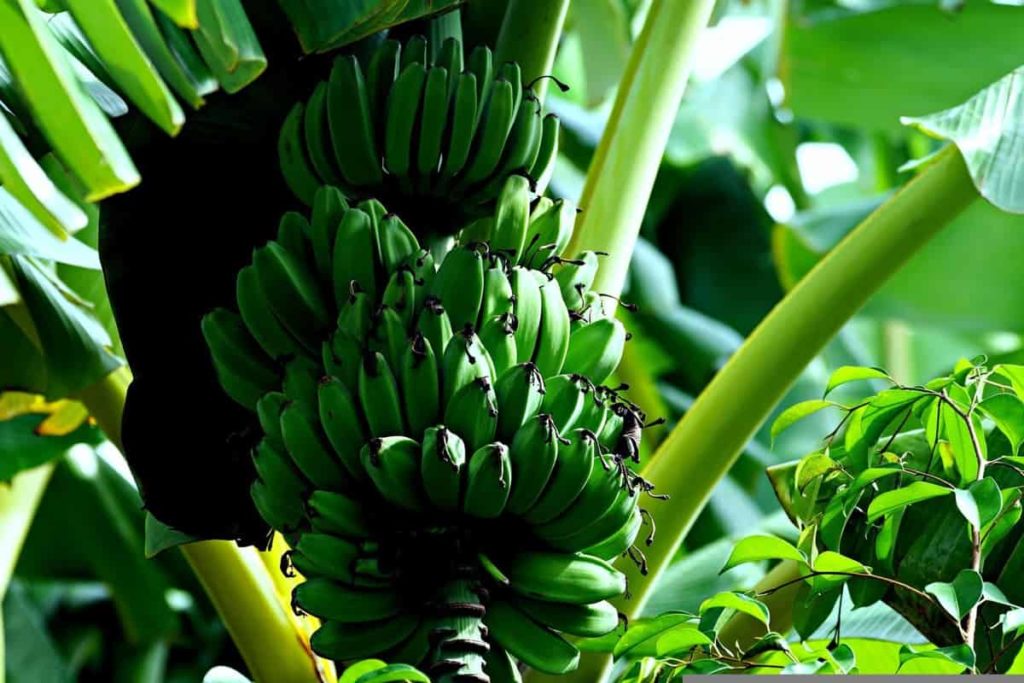
The Comfrey is one of the most popular companion plants. This flowering plant attracts pollinators, adds nitrogen to the soil, and makes a good mulch. All the things that are necessary for Banana plants. It is no secret that plants need three basic nutrients: nitrogen, phosphorus, and potassium.
Fortunately, Comfrey provides a natural source of nitrogen. To do this, Comfrey takes nitrogen out of the air and stores it in the soil through its roots. It also has a deep taproot to work nitrogen a long way in the soil. Tomatoes should not be planted too close to Banana plants, as they are not water lovers like Bananas.
- Growing Gold: Essential Techniques for Planting Pineapples
- How to Make Kalanchoe Plant Bushy: Home Remedies and Solutions
- 11 Reasons Why Your Gardenia is Not Blooming: Home Remedies and Solutions
- Eco Elegance: The Guide to Designing a Drought-Tolerant Landscape
- Gardening on a Slope: Strategies for Hillside Landscaping
- Nourish and Flourish: Top Organic Mulches for Thriving House Plants
- Everything You Want to Know about Indian Mogra Flower: Discover Uses and Growing
- Green Thumb Success: Expert Tips for Cultivating Greenhouse Pumpkins All Year Round
- Maximize Growth & Flavor: The Ultimate Guide to Companion Planting in Herb Gardens
- How to Control Rhododendron Problems Naturally: Home Remedies and Organic Ways to Fix Them
- Natural Magic: The Remarkable Benefits of Cinnamon for Plants
- Best Steps to Revive Dying Tulip with Natural and Organic Treatment
- 10 Reasons Why Your Angel Trumpet is Not Blooming: Remedies and Treatment
- How to Fix Periwinkle Leaf and Flower-Related Problems: Natural Remedies and Solutions
- How to Fix Zinnias Leaf and Flower Problems: Discover Natural and Home Remedies
- Organic Steps to Induce Lemon Tree Flowers: A Comprehensive Guide
- Bloom Booster: Crafting the Perfect Homemade Bougainvillea Fertilizer
- Optimizing Growth: A Guide to Applying NPK Fertilizer for Potted Plants
- 10 Best Homemade Fertilizers for Rubber Plant: DIY Recipes and Application Method
- How to Boost Female Pumpkin Flowers: Effective Steps for More Flowers and High Yields
- Transform Your Indoor Garden: Top Benefits of Pink Salt for Houseplants
- 10 Best Homemade Fertilizers for Peacock Plants (Calathea): Easy DIY Guide
- Unlock Blooms: 9 Reasons Why Your Potted Chrysanthemum is Not Blooming
- 8 Reasons Why Your Potted Hibiscus is Not Blooming: Fix it with Simple Solutions
- Unlock Blooms: 9 Key Reasons Your Potted Frangipani Won’t Flower
- 10 Reasons Why Is My Ice Plant Not Blooming: Remedies and Treatment
- 10 Reasons Why My Potted Hydrangea Not Blooming: Treatment and Remedies
- 10 Reasons Why is My Wisteria Not Blooming: Remedies and Treatment
- 10 Reasons Why is My Goldfish Plant Not Blooming: Remedies and Treatment
- Maximize Your Space: Ultimate Guide to Balcony Gardening with Grow Bags
- 10 Reasons Why Your Iris is Not Blooming: Remedies and Treatment
- 10 Reasons Why Your Anthurium Plant is Not Blooming: Treatment and Remedies
- 10 Reasons Why Your Aquaponic Plants Are Not Flowering: Remedies and Treatment
- 10 Reasons Why Your Agapanthus is Not Flowering: Remedies and Treatment
- Ultimate Guide to Brown Turkey Fig: Steps to Growing Brown Turkey Figs
- How to Grow Acai Berry: Propagation, Planting, and Care
